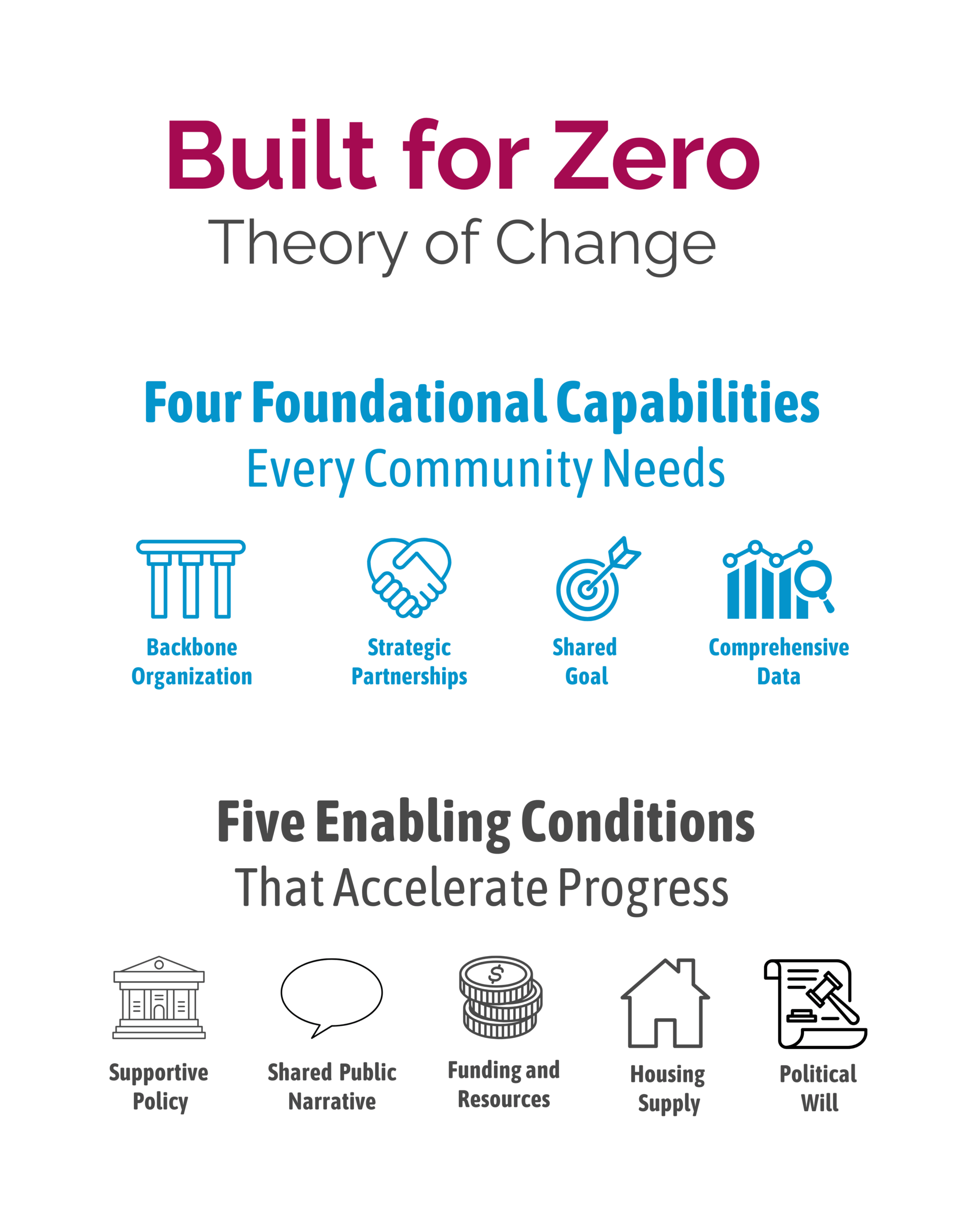Introduction
Over the past decade, Community Solutions’ Built for Zero initiative has shown that making homelessness rare and brief is achievable. In communities across the country, success has reflected the same powerful pattern:
- communities achieve sustainable, population-level reductions when their homeless prevention and response system is grounded in four foundational capabilities, and
- their progress accelerates when the broader environment provides five enabling conditions.
This Theory of Change is a synthesis of our learnings from work with over 140 communities, bolstered by findings from an independent evaluator, ORS Impact. It provides a practical tool — a shared reference point to enable communities to identify gaps in their system, target strategies, and strengthen collective practices and impact. As the Built for Zero method scales — including through open-source adoption — this framework can guide communities in implementing new, outcomes-focused homelessness response systems.

Together, these elements form a clear, evidence-based checklist for diagnosing barriers to progress, aligning interventions, and sustaining results. Importantly, it also simplifies the Community Level Theory of Change into a clear, actionable structure, making it easier to communicate, operationalize, and track progress across diverse teams and contexts.
The Four Foundational Capabilities Every Community Needs
| # | Capability | Definition |
| 1 | Backbone Organization | A central entity (e.g., CoC, local government, community-based organization) that aligns efforts, mobilizes resources, and builds political will to achieve shared community-level goals. |
| 2 | Strategic Partnerships | Cross-sector relationships, formal and informal, bringing together housing, health, justice, philanthropy, business, elected officials, government, and people with lived expertise into a coordinated, accountable change effort. |
| 3 | Shared Goal | Community-wide, measurable targets embraced by partners, embedded in resource allocation, policy, and strategy, and communicated publicly. |
| 4 | Comprehensive Data | Real-time, person-level information system tracking inflow, outflow, actively homeless individuals, returns to homelessness, and time-to-housing. Data must be grounded in shared definitions and quality assurance practices to triage individuals effectively. |
The Five Enabling Conditions that Accelerate Progress
| # | Condition | Definition |
| 1 | Supportive Policy | Local policies that remove barriers, uphold person-centered approaches, and enable coordinated, timely, data-driven responses to actual conditions. |
| 2 | Shared Public Narrative | A consistent, widely-held message, reinforced by leaders, media, and institutions, framing homelessness as solvable with local accountability for results. |
| 3 | Funding & Resources | Sufficient, diversified, and flexible funds (public, private, philanthropic), to enable funding of effective emergency responses and ongoing system infrastructure. |
| 4 | Housing Supply | Adequate and appropriate housing units available that meet basic needs and range of household budgets. |
| 5 | Political Will | Committed support and leadership from elected officials and policymakers to prioritize making homelessness rare and brief, and for overcoming barriers, approving policies, allocating funding, and improving cross-agency collaboration. |
Ways of Working
To strengthen implementation efforts, communities should integrate the following practices across all elements of the framework:
Person-Specific Approach: Identify and close gaps across populations, using shared, disaggregated data to set targets, track disparities, and ensure equitable progress.
Collaborative Practice: Within the Backbone structure, co-develop community-wide strategies, share data, coordinate resources, align workflows, maintain open communication, and accountability with meaningful participation from those with lived experience.
Continuous Improvement: Adopt a learning culture. Use shared data to test ideas for reducing homelessness, scaling up successful ones, and quickly adjusting or moving on from the misfires. Ground decisions in shared data and evaluation findings, prioritizing opportunities for greatest impact on overall reductions in homelessness
Proactive Solutions: Communities that prioritize preventive, forward-looking strategies — rather than reactive measures — achieve the strongest results. They anticipate challenges by using data, engaging community members, and incorporating feedback from the people the system serves, enabling them to intervene further upstream.
Conclusion
This framework provides a flexible yet structured approach for any community to apply to organize efforts, assess progress, effectively adapt strategies and direct collective resources for maximum impact in making homelessness rare and brief. These elements-adaptly locally — are found across successful communities regardless of context.
Homelessness is deeply rooted in place — shaped by unique histories, geographies, politics, and resources — and requires context-specific solutions. When communities pair these solutions with the common framework laid out here, measurable progress follows. Together, we can move from managing homelessness to ending it.




